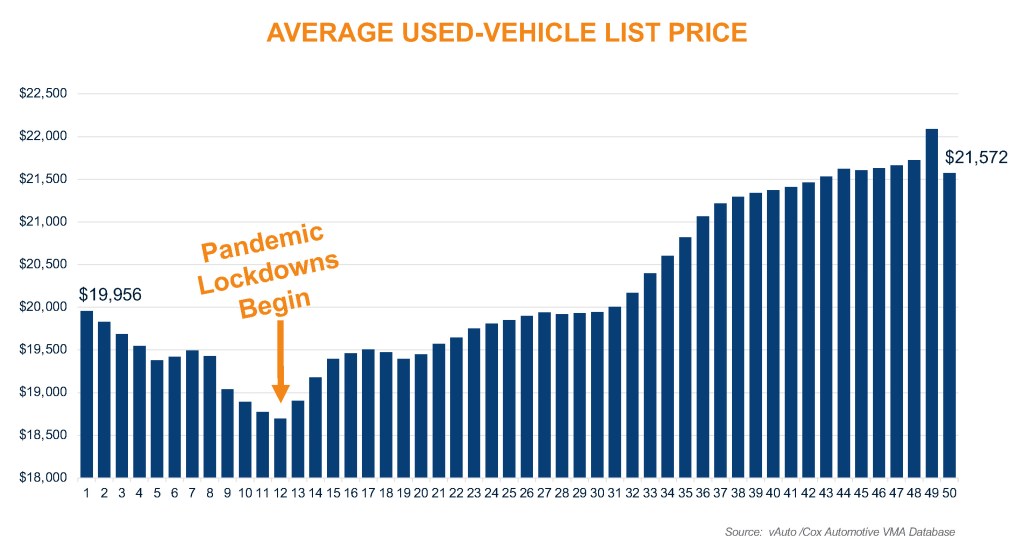Data Point
Used-Vehicle Supply Dips as Sales Pace Quickens
Thursday February 18, 2021
Article Highlights
- Used-vehicle supply dipped to 48 days.
- The average used-vehicle list price slipped to $21,572.
- During January, used-vehicle sales trended higher near the end of the month.
Used-vehicle inventory and prices slipped a bit in January as the sales pace for the month quickened, according to a Cox Automotive analysis of vAuto Available Inventory data.
2.66M
Total Unsold Used Vehicles
end of January
48
Days’ Supply
$21,572
Average Listing Price
66,545
Average Miles
The total U.S. supply of unsold used vehicles closed January at 2.66 million vehicles, down from 2.68 million at the end of December 2020. It has remained roughly at that level of supply since early December. But the supply remains below the comparable week a year ago when it was at 2.94 million.
In January, the used-vehicle days’ supply was 48, down from 55 at the end of December and 2% below a year ago. The days’ supply ticked down as January wore on due to improving sales.
The Cox Automotive days’ supply is based on the daily sales rate for the most recent 30-day period. During January, sales trended higher near the end of the month though still remained behind year-ago levels.
“Inventories are tightening just as we are about to kick off the spring selling season,” said Cox Automotive Senior Economist Charlie Chesbrough. “Historically, spring has seen strong used-vehicle sales due, in large part, to tax returns and maybe some weather-induced optimism.”
He added: “This year, government stimulus checks may further support demand from used-vehicle buyers, who are an income group likely to qualify for upcoming COVID-19 relief checks. The combination of tight inventories and strong demand suggests already high prices may go even higher.”
The average list price retreated from record levels. The average used-vehicle list price at the end of January was $21,572, down from the month’s peak of $22,131 in early January and the record-setting $22,087 at the end of December 2020, according to a Cox Automotive analysis of vAuto Available Inventory data. At the depth of the pandemic, the week of March 23, the average list price bottomed out at $18,681 and steadily rose thereafter.
“Listing prices have receded from their recent peaks, but they are still elevated at 10% over last year,” said Chesbrough. “Within the newer model year used sales, the vehicle mix is going to have a growing share of SUVs and pickup trucks as the years of falling new car sales dictates. This mix will produce a higher average price in the used market, just as it did when sold as new. The trend of higher used prices is likely to continue, and stimulus checks during tax season may add fuel to the fire.”
Franchised dealers started February with 1.47 million used vehicles in inventory for a 43 days’ supply. Used vehicles are turning quickly as franchised dealers started January with 1.51 million available vehicles for a 50 days’ supply.
Independent dealers had an available supply of 1.12 million vehicles for a 56 days supply. Similarly, vehicles are turning fast as independent dealers started January with an available supply of 1.16 million vehicles for a 61 days’ supply.
The average list price for franchised dealers was $23,221, down from $23,783 the month earlier. It was $19,139 for independent dealers, down from $19,631 the previous month.
The days’ supply again was lowest for used vehicles listed at under $10,000, which represents a small part of the market. In January, the days’ supply for that price class dropped significantly to 37 from 43 the month earlier.
Inventory for used vehicles in the highest volume price categories – $10,000 to $30,000 – had days’ supply between 45 and 50, after being between 52 and 58 days’ supply the month earlier.
Among mainstream brands, days’ supply is in a generally tight range, between 42 and 58.
For non-luxury brands, Toyota, as is the case on the new side, had the lowest inventory at 42 days’ supply. Chevrolet, GMC, Honda, Kia, Mazda, Nissan, Subaru and Volkswagen were below the industry average of 48 days’ supply. The rest were at or just above the average. Dodge was the highest by a wide margin at 77 days’ supply. Mitsubishi was also at the high end.
Among mainstream luxury brands, Lexus, as it was in January on the new-vehicle side, had the lowest inventory at 47 days’ supply. Infiniti was the only other luxury make with below-average inventory. The rest were above 50 days’ supply with Alfa Romeo the highest at 78 days’ supply.
Michelle Krebs is executive analyst at Cox Automotive.

